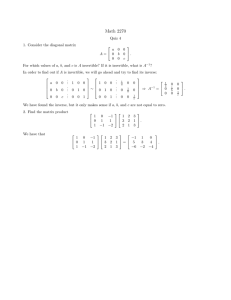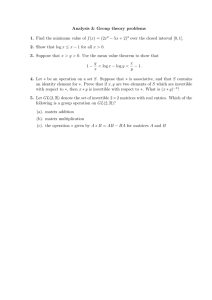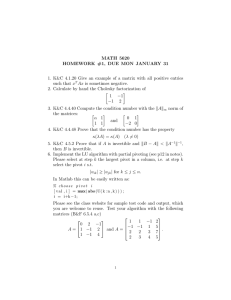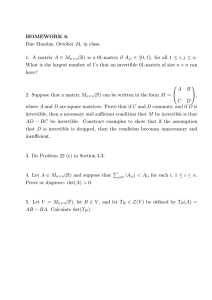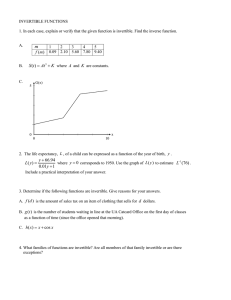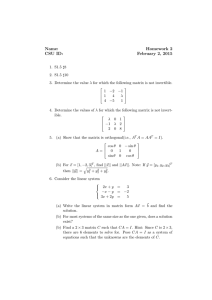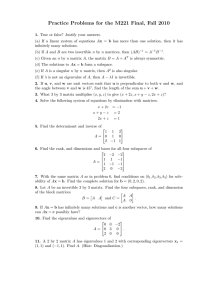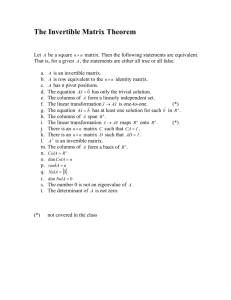These are brief notes for the lecture on Wednesday September 8
advertisement
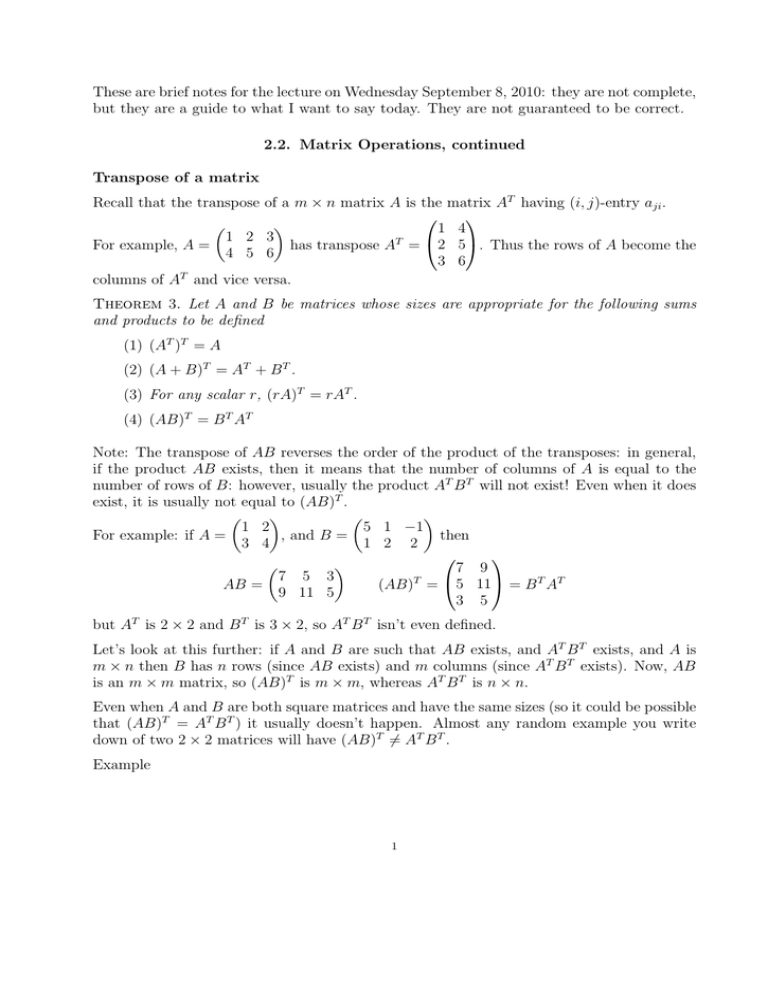
These are brief notes for the lecture on Wednesday September 8, 2010: they are not complete, but they are a guide to what I want to say today. They are not guaranteed to be correct. 2.2. Matrix Operations, continued Transpose of a matrix Recall that the transpose of a m × n matrix A is the matrix AT having (i, j)-entry aji . 1 4 1 2 3 For example, A = has transpose AT = 2 5. Thus the rows of A become the 4 5 6 3 6 T columns of A and vice versa. Theorem 3. Let A and B be matrices whose sizes are appropriate for the following sums and products to be defined (1) (AT )T = A (2) (A + B)T = AT + B T . (3) For any scalar r, (rA)T = rAT . (4) (AB)T = B T AT Note: The transpose of AB reverses the order of the product of the transposes: in general, if the product AB exists, then it means that the number of columns of A is equal to the number of rows of B: however, usually the product AT B T will not exist! Even when it does exist, it is usually not equal to (AB)T . 5 1 −1 1 2 then , and B = For example: if A = 1 2 2 3 4 7 9 7 5 3 AB = (AB)T = 5 11 = B T AT 9 11 5 3 5 but AT is 2 × 2 and B T is 3 × 2, so AT B T isn’t even defined. Let’s look at this further: if A and B are such that AB exists, and AT B T exists, and A is m × n then B has n rows (since AB exists) and m columns (since AT B T exists). Now, AB is an m × m matrix, so (AB)T is m × m, whereas AT B T is n × n. Even when A and B are both square matrices and have the same sizes (so it could be possible that (AB)T = AT B T ) it usually doesn’t happen. Almost any random example you write down of two 2 × 2 matrices will have (AB)T 6= AT B T . Example 1 2.3. The Inverse of a Matrix Suppose we have a linear transformation T : Rn −→ Rm : we will say that the linear transformation has an inverse transformation if for every b ∈ Rm there is exactly one x ∈ Rn so that T (x = b. Note that if T is invertible, this means that T is onto (every equation can be solved: hence m ≤ n) and T is 1-1 (every equation has at most one solution: hence n ≤ m). Hence an invertible linear transformation has a matrix which must be square. Which square matrices are invertible? What does it mean for a square matrix to be invertible? Suppose that T : Rn −→ Rn is an invertible linear transformation: then we can define S : Rn −→ Rn so that T x = u if and only if x = Su. Furthermore, for every vector x ∈ Rn , S(T (x)) = x, and for every u ∈ Rn , T (S(u)) = u. It turns out that S must also be linear: we’ll assume that T (x) = u and T (y) = v. Then S(u) = x and S(v) = y. We’ll show that S(ru) = rS(u). Indeed, S(T (rx)) = rx, so we get S(ru) = S(rT (x)) = S(T (rx)) = rx = rS(u) so that S commutes with scalar addition. Likewise, S(u + v) = S(T (x) + T (y)) = S(T (x + y)) = (x + y) = S(u) + S(v) so that S commutes with addition. So we see that if T is an invertible linear transformation from Rn to Rn , so is S. Hence we can represent T by a square matrix A and S by a square matrix B. Then S(T (x)) = x for all x means that BAx = x for every x. In particular, if C = BA, then we have Cej = ej , so that we obtain that C must be the identity matrix In . Similarly, T (S(u)) = u for every u, and hence AB = In is also the identity matrix. Definition. An n×n matrix is invertible if there exists a n×n matrix B so that AB = In = BA. B is called the inverse of A and is denoted by A−1 . A matrix which is not invertible is said to be singular. 2 For 2 × 2 matrices we have a very simple form for the inverse. a b Definition. Let A = . We define (and this only works for 2 × 2 matrices) the c d determinant of A to be the quantity det(A) = ad − bc. a b Theorem 4. Let A = . Then A is invertible if and only if det(A) is non-zero, in c d which case 1 d −b −1 . A = det(A) −c a If det(A) = 0 then A is singular. Proof: Theorem 5. If A is an invertible m × m matrix, then for every b ∈ Rn , the equation Ax = b has a unique solution, namely x = A−1 b. Proof: 3 Theorem 6. (1) If A is invertible, then so is A−1 , and its inverse is given by (A−1 )−1 = A . (2) If A and B are invertible n × n matrices (that is, they are both invertible and they are the same size) then AB is invertible, and (AB)−1 = B −1 A−1 . (3) If A is invertible, then so is AT , and its inverse is given by (AT )−1 = (A−1 )T . Proof: 4
